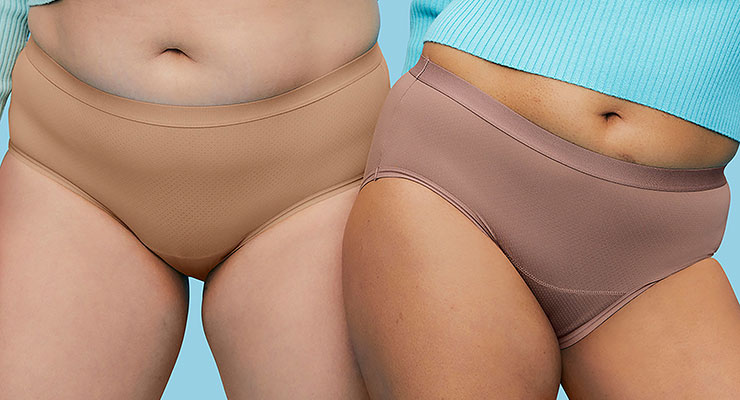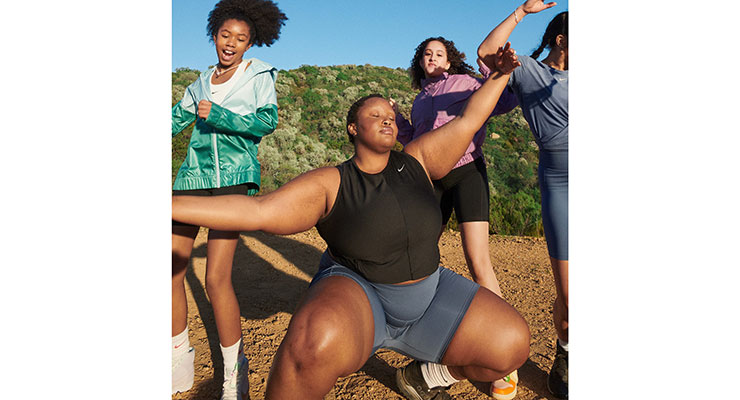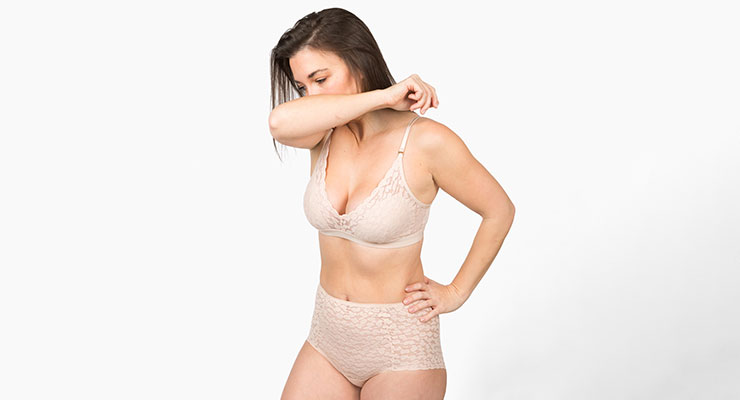Karen McIntyre, Editor03.01.24

The entry of reusable product formats like washable pads and underwear for bladder leaks and menstrual care is changing the landscape of the hygiene market. As consumers and retailers seek to lessen the impact of hygiene products on landfills, usage of these products continues to grow, outpacing growth in typical hygiene categories. However, challenges—many of which are related to pricing—have made doing business in this market difficult, leading manufacturers to find ways to create products more economically.
Frantisek Riha-Scott founded reusable hygiene company Confitex 10 years ago with the hopes of transforming lives and reducing waste through the creation of the ultimate reusable absorbent hygiene product. “Innovation and technology can definitely improve the sustainable ecosystem, firstly by creating better-performing and more practical products that people trust and want to use, secondly by enabling them to be made more sustainable, and thirdly, by enabling them to be made more affordably so more people can access them,” he says.
To achieve these goals, Confitex relies on market-leading technology and automated manufacturing to make washable products that can rival the performance of single-use pads on a large enough scale to make them affordable and accessible to the masses.“Economic sustainability is important because it’s only when reusable solutions are as reliable, convenient and affordable as single use pads and liners that they will be widely enough adopted to really make a dent on the number of single-use absorbent hygiene products filtering into the market,” Riha-Scott adds.
Liying Qian, industry manager, tissue and hygiene, Euromonitor, says that the research firm is not quite sure how much pricing is influencing consumers to switch to reusables, but up-front pricing continues to be a barrier for adoption as reusable hygiene products are more expensive than disposables.
“Businesses have responded with two approaches to capture more consumers, especially lower-income shoppers and teens,” she explains. “Some have launched more accessibly priced goods in mass retailers, while some others are focused on adding value by expanding absorbency/mileage and comfort and merging leakproof function with specialized, aesthetic and occasion-based design in the form of sportswear, swimwear and shapewear.”
This has created a crowded playing field in the market with companies ranging from Hanes to Nike to Aerie offering undergarments and sportswear that offer some level of leak protection at a wide range of price points. Pricing, in particular, has become an issue, as new product entries create a more competitive landscape.
“You cannot enter the washable market with a me-too product, which you can only do on price,” adds Henning Röttger, head of business development at hygiene manufacturer pelzGroup. “We are looking at value-based pricing, not cost-based pricing—because the second has really challenged the industry limiting innovation.”
Reuse to Reduce
Superabsorbent fiber specialist Technical Absorbents operates a needlepunch line that can incorporate absorbency right into a washable fabric for the reusable hygiene space. Recent developmental efforts at the company have focused on balancing performance, lifecycle assessment and costs.
Saalt has added an overnight version to its reusable absorbent underwear line.
“We continue to work with many established and start-up hygiene companies, who are looking to improve functionality and overall performance of their reusable period and incontinence pads and pants,” says product development director John Rose. “This includes a demand for higher absorbency and retention levels, and a desire to enhance the lifecycle of the products by increasing the number of wash/dry cycles their products can withstand. These are coupled with the continued requirement to keep drying times as low as possible.”
As washable products have become more accepted by the market, the drive to enhance performance has increased, Rose adds. “From a development perspective, there are very fine margins involved—increasing absorbency means that drying times can be lengthened, and so our project work is currently centred around ensuring we get the right balance to meet the needs of our customers.”
From the hygiene manufacturer’s point of view, the market for reusable hygiene is nascent but already competitive. Competitiveness will only breed innovation as more consumers recognize the advantages of these products.
“Only a small minority of consumers have adopted reusable products, but those that have rave about the experience,” says Cherie Hoeger, CEO and co-founder of Saalt. “Even leading companies in the reusable category are still in early rounds of innovation, and there is ample room to continue to improve upon better alternatives to disposables. Thinness, dryness and total absorbent capacity are all areas we are focusing on improving the technology.”
Chasing Comfort
While waste reduction is a key driver in the conversion to reusable hygiene products, other factors like comfort, discretion and long-term cost effectiveness are also playing a role. Whether the item is for menstrual care or incontinence, the product formats offer the wearer a more comfortable and discreet option.“According to our consumer survey about usage of various hygiene products including reusables, we have broadly seen growth in adoption of reusables over the past few years. The growth of adoption is most notable in incontinence, followed by menstrual care,” Qian says. “Reusables include not only the luxurious, pleasant-looking underwear increasingly seen on the retail shelf in developed markets, but also cheaper, DIY-ed cloth makeshifts. This can be partially attributed to stronger stigma and higher product cost and access barriers in the incontinence market, compared to other hygiene segments.”
The rate of adoption is evident in category growth, which is estimated at about 20% per year, significantly more than the single-digit growth seen in traditional hygiene categories. The share of reusables in the overall category is expected to reach 15%, up from today’s 7%, in the next five years.
As part of its effort to be a global leader in the intimate apparel category, Essity has invested heavily in this segment. After launching washable absorbent underwear for both menstrual care and incontinence care through its own brands in 2021, the Swedish hygiene manufacturer made dual acquisitions in the category in late 2022. Modibodi, an Australian startup, and North American-based Knix both offer market-leading reusable solutions for the leakproof apparel market.
“In both these categories (feminine hygiene and bladder leakage), leak-proof is quickly growing as a subsegment, replacing liners, pads, disposable pads and the typical products,” says Magnus Groth, CEO of Essity. “Leak-proof apparel is more sustainable than disposable products. Typically, the CO2 impact is about half of using disposables and these products generate about 75% less waste using reusable products.”
Kimberly-Clark showed its optimism in the category in early 2022 when it bought a majority stake in Thinx—after acquiring a 25% stake in 2019. Thinx is a reusable brands credited with creating the category when it launched over a decade ago. At the time of the acquisition, K-C executives called the move a major step in building its portfolio of period and light bladder leakage.
However, post acquisition, Thinx seems to be struggling to find its footing in the market with sales down a reported 30%, to $60 million, last year as the company tried to balance its founding values as an industry disruptor while becoming a household brand sold at mass retailers. Additionally, in January 2023, Thinx settled a $5 million lawsuit that accused the company of lying about the toxicity of its products, which contain trace levels of PFAS. In addition to the financial strain of the settlement, the negative publicity hurt the company that had been founded on transparency and touted a non-toxic product.
While K-C has made no public announcement related to Thinx, in January the brand reportedly announced to employees that it would be wholly integrated into the parent company. Additionally, 95 of its 109 employees will be laid off in May.
Longer Life
New technologies—both woven and nonwovens—as well as innovation in absorbent fibers have allowed reusable hygiene products to be as effective in preventing leaks and odors as disposables with a much lower environmental impact. One disposable pad takes between 500-800 years to biodegrade and each year 20 billion pads and tampons are adding to North American landfills. Meanwhile, many of these reusable garments, when cared for properly, can last up to two years or longer.While pelzGroup has focused on sustainable alternatives within the hygiene market including the development of a plastic-free, yet disposable, pantyliner last year, the company is venturing into reusables, which have an even lesser impact. Along with a retail partner, the company is currently preparing to launch a hybrid hygiene product system that contains a washable pant with a disposable core for light bladder applications.
The absorbent pad comprises an airlaid core with a high amount of superabsorbent polymer wrapped in a cotton spunlace nonwoven. For men, the pouch is in the front; while for women it is in the same location as a panty liner. The strip is able to absorb 100 milliliters of liquid—making it ideal for light to medium incontinence and menstrual care applications—and is very easy to change. Future generations of the pad planned to be introduced in 2025 will be flushable, which is especially attractive to male incontinence sufferers who don’t have as many disposal options in public bathrooms.

Reusable hygiene companies are removing stigmas surrounding menstruation.
Unlike disposable or washable absorbent underwear, the incorporation of a replaceable high performance absorbent liner allows for easier changes after insult because the wearer can slip the pad in and out without removing the complete garment. This allows for the disposal of urine in smaller charges enabling the use of more or less regular underwear even for people suffering from medium incontinence. It also creates significantly less waste than other formats. Also, unlike washable formats, the liner contains SAP securely locking the urine and can better manage odor control. pelzGroup has also filed patents for a flushable absorbent strip only using plant-based materials which will solve the issue of disposing the used article and reduce the amount of plastic waste to zero.
pelzGroup has recently partnered with a branded customer to introduce the products in certain countries and Europe and Asia, starting in Germany, in summer 2024. The initial product will be a non-flushable exchangeable core and will be followed by the plastic-free flushable core in 2025. The flushable core will be compatible with the washable underwear introduced this year.
Another hybrid design has been created by Kelheim Fibres, in partnership with a German design team. The result is a durable fitted cloth baby diaper made from a waterproof cover containing a sewn pocket and washable absorbent pads. The diaper, which is known as Sumo, cannot only be laundered many times, it is also fully biodegradable.
The Sumo diaper system—and the Ufo removable superabsorbent inlay—rely on plant-based fibers which the founders say outperform polyester and cotton—the main material in most reusable diaper systems. The absorbent pad shows about a 40% reduction in rewet value and a reduction in acquisition time by about 45% compared to polyester and 40% compared to cotton. At the same time, the product is thinner, weighs less and is air permeable.
Kelheim assisted with the development of the core using a combination of needlepunch and thermal bonded technologies on its Galaxy trilobal viscose fibers. The needlepunch gives both fibers types more space to absorb liquid and higher storage volumes, while thermal bonding offers bulkiness and increases strength, allowing the nonwoven to be fully washable. Additionally, in the absorbent core, Kelheim’s segmented hollow fiber Bramante stores liquid not only between but also within the fibers. Bramante can absorb up to 260% of its own weight. The core also contains polylactic acid (PLA).

Bloomers Intimates recently launched SneezeProof styles to its lineup.
New Uses for Reusables
As the use of reusable leakproof products continues to expand, so has the scope of the product with manufacturers introducing new product formats to serve other hygeine-related needs. Earlier this year, Essity-owned Knix introduced leakproof Shapewear products, which are said to absorb about 0.8–3 teaspoons of liquid, which is the equivalent of about one to three regular tampons or about one to two pantyliners. According to the company, Knix Shapewear combines form, fashion and function allowing the wearer to combine the benefits of an absorbent item and shapewear in one product.For overnight care Saalt has launched the newest addition to its collection of period and leak-care products: the Saalt Sleep Short. Made from the softest, gentlest natural cotton, this sleep short features a fully wrapped super-absorbency gusset that extends from the front waistband all the way to the back. It can replace six regular pads or eight regular tampons. Ultimate peace of mind leaves users comfy, confident, and leak-free all night long.
“We spent over a year developing the right combination of materials to build the Super Absorbency gusset that still felt thinner and drier than competitor options,” says Hoeger. “Balancing a higher absorbent capability with the comfort and flexibility our customer expects from Saalt was challenging, but worth the time dedicated to get it right. For an overnight product, we wanted to create something that would truly give customers peace of mind and protection against stained sheets, no matter if they sleep on their stomachs or their backs.”
Another new launch, Bloomers Intimates’ SneezeProof, has the look of sexy and comfortable lingerie with a light absorbent panel that wicks away moisture to keep women and their clothing dry, allowing them to enjoy everyday activities with peace of mind. Bloomers’ SneezeProof styles use the same soft four-way stretch lace, full rear coverage, scalloped edge and comfortable fit that make Bloomers Intimates’ other styles so popular.
“Our customers have asked for leakproof solutions since we first started offering our best-selling sexy granny panties,” says Dr. Shaula Yemini, co-founder. “Leaks are just one of the lovely surprises that can occur as our bodies change. But it took time to develop a solution that is absorbent, lightweight, and feels just as soft and comfortable as our regular cotton gusset.”
Yemini’s co-founder Noa Arias, the company’s CEO, stresses the product is not for menstrual or incontinence care, just for everyday leaks.
“SneezeProof undies are for common everyday leaks that we all experience, whether it’s while laughing a bit too hard at a funny joke or during a coughing fit,” she says.

